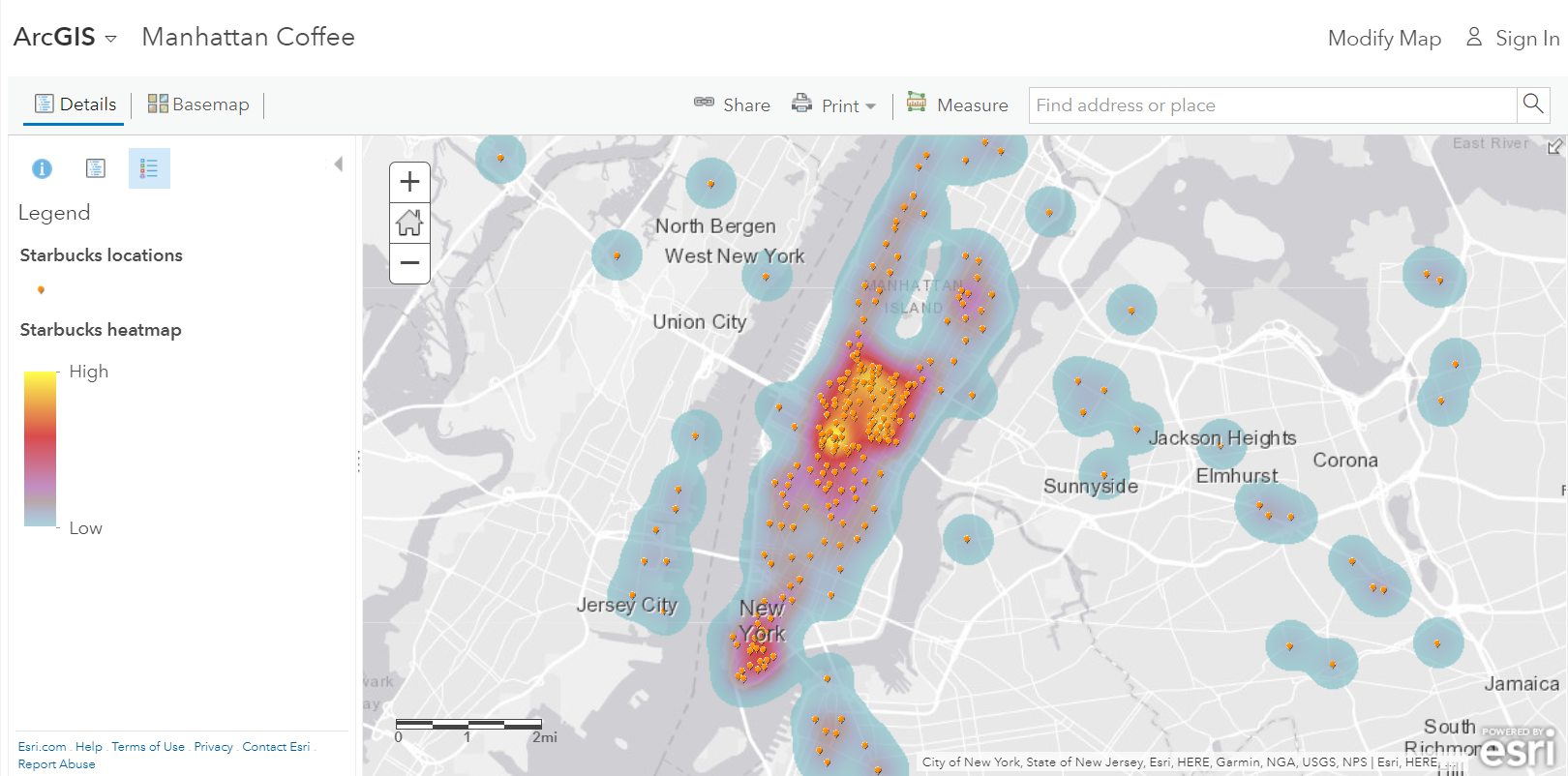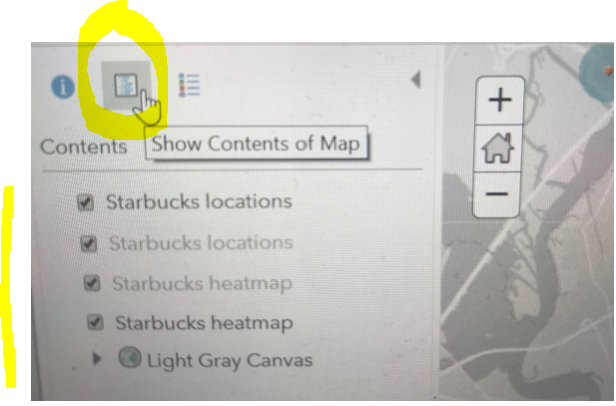- Home
- :
- All Communities
- :
- Industries
- :
- Education
- :
- Education Blog
- :
- Examining business locations to foster spatial thi...
Examining business locations to foster spatial thinking
- Subscribe to RSS Feed
- Mark as New
- Mark as Read
- Bookmark
- Subscribe
- Printer Friendly Page
- Report Inappropriate Content
Examining the locations of businesses can also foster spatial thinking and enhance skills in Spatial Technology. In the business world, location is usually the factor in determining whether it will thrive or fail.
Let’s have a coffee break. Examine this interactive web map of Starbucks coffee establishments around the world. The map is based on ArcGIS from Esri:
http://www.arcgis.com/home/webmap/viewer.html?webmap=ec6fe7b6dacc4c91ba89f1eb7a9df217
 Manhattan and Beyond. The map opens with a view centered on Manhattan, one of the boroughs of New York City. The data are displayed as points and also as a heat map. A heat map shows the relative clustering of data, with “hot” or “bright” colours indicating clustering of a certain variable or feature, and “cool” or “green-blue” colours indicating areas containing fewer of a specific variable or feature.
Manhattan and Beyond. The map opens with a view centered on Manhattan, one of the boroughs of New York City. The data are displayed as points and also as a heat map. A heat map shows the relative clustering of data, with “hot” or “bright” colours indicating clustering of a certain variable or feature, and “cool” or “green-blue” colours indicating areas containing fewer of a specific variable or feature.
Clustering. Why are Starbucks clustered in this part of the New York City and not in other parts? To assist your answer, use Basemap > change the basemap to Imagery with Labels. Zoom in to Manhattan. You can use the Show Contents of Map button to display the map layers, and then toggle them on and off as shown below (or make them semi-transparent from a menu from the (…) choice when you click on and expand the individual layers).

Starbucks in Australia. Enter Sydney in the search box to the upper right of the map and select Sydney, NSW, Australia. The map should look similar to that below. Why are Starbucks clustered in this part of the city?

In the search box, enter Jilliby and zoom to Jilliby in New South Wales Australia. Would you say that Jilliby is larger or smaller than Sydney? Do some research to back up your observation. Why, according to this data set, are there no Starbucks in this town? Think about specific types of business—a petrol station, convenience store, concert hall, home improvement store, airport—they all have different population thresholds that they must meet. Some are viable in a small town or even in no town at all, while others, such as IKEA or other chains with a large footprint, need a large nearby population base to stay in business.
Extend this activity. How are Starbucks distributed in other major cities around the world? Shanghai? Chicago? London? How does the type of product influence where it expands globally? The headquarters of Starbucks is in Seattle Washington in the northwest corner of the continental USA. How does the location of the headquarters of a chain influence where, how, and the rate at which it expands? Name 2 other factors that influences if and when a business could expand. What 2 factors influence Starbucks expansion? Name 2 other chain businesses that have spread regionally, 2 that have spread nationally, and 2 that have spread globally. Which of these chains have you visited?
By examining these other questions, you can begin to see that Spatial Technology can serve as a springboard for inquiry, for critical thinking, and for thinking across disciplinary boundaries. The activity above, for example, touched on geography, but also sociology (consumer preferences), and economics (prices, personal income, global trade).
Think outside the box! You can map the location of any business as point data in ArcGIS . Think about mapping two types of businesses in your community, for example, car washes versus antique stores. Why do the exhibit different spatial patterns?
Be critical of data—including maps. In this and other GIS-based investigations, always investigate the source of the data. Where did it come from, who created it, at what scale was it created, is it curated, is it trustworthy? These are elements of what we call metadata, which is especially important in mapping. In this case, the Starbucks metadata does not contain much information, but there is some information here: http://www.arcgis.com/home/item.html?id=33f0d1a9b4d6453e8f6110c9eb2c36d5 What is the date of the Starbucks data?
Think about which data you might want to map where having data 10 years out of date is OK (such as geologic strata of Turkmenistan) and when even 1 day out of date is not OK (such as mapping current wildfires in Australia).
Thus, be critical of the data. Make sure students question all data on the web, including maps! Maps have an aura of authenticity and are often taken as “the truth.” Nowadays, anyone can make a map and post it to the web. That is wonderful, and empowering, but also requires you to be a critical consumer of data. All maps are inaccurate, because they are representing the oblate spheroid that is the Earth on a 2D or even projected 3D image on your computer screen. Furthermore, maps, including satellite imagery, are only representations of reality—and hence, are symbolized and generalized and processed in various ways. There are many maps that show false information, and also, many maps that may be useful but contain no metadata. Despite their limitations, maps are incredibly useful. But to make effective use of maps, make sure you understand their limitations and encourage students, coworkers, and others to be critical of them.
You must be a registered user to add a comment. If you've already registered, sign in. Otherwise, register and sign in.
-
Administration
38 -
Announcements
45 -
Career & Tech Ed
1 -
Curriculum-Learning Resources
179 -
Education Facilities
24 -
Events
47 -
GeoInquiries
1 -
Higher Education
519 -
Informal Education
266 -
Licensing Best Practices
46 -
National Geographic MapMaker
11 -
Pedagogy and Education Theory
187 -
Schools (K - 12)
282 -
Schools (K-12)
185 -
Spatial data
24 -
STEM
3 -
Students - Higher Education
231 -
Students - K-12 Schools
86 -
Success Stories
22 -
TeacherDesk
1 -
Tech Tips
83
- « Previous
- Next »